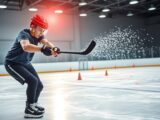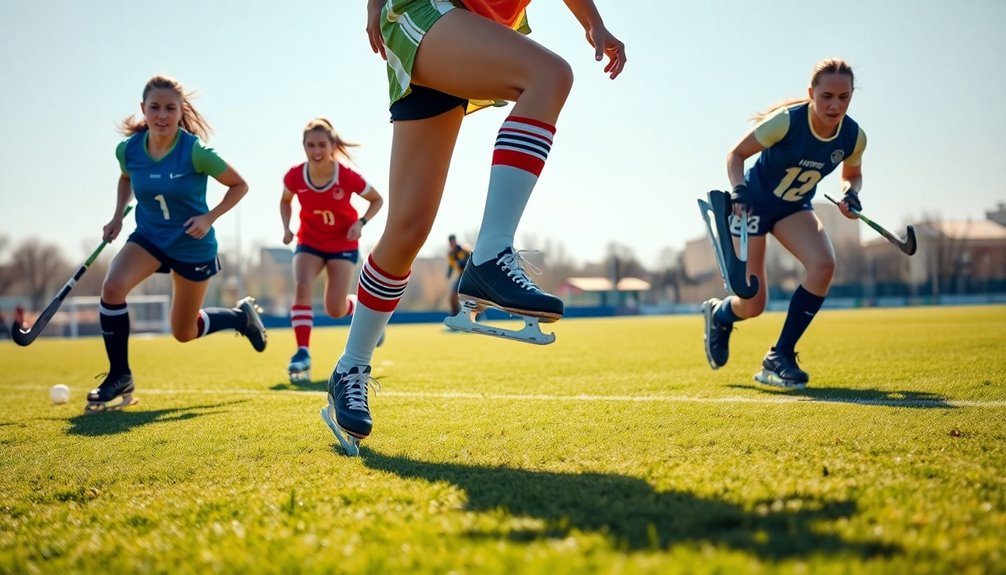
Crossovers Workouts: Perfect for Ice and Field Hockey
December 30, 2024Crossover workouts are essential for both ice and field hockey players. They boost your agility, allowing for quick directional changes and enhancing your elusiveness against defenders. By focusing on proper body positioning and knee bend, you'll maximize your power and speed. Incorporating drills that improve core strength and ankle mobility will strengthen your balance and stability, making you faster on the field or ice. Don't forget to practice consistently to see noticeable improvements in just a month. Curious about how to create a tailored crossover workout plan? There's plenty more to explore on this topic!
Importance of Crossovers in Hockey
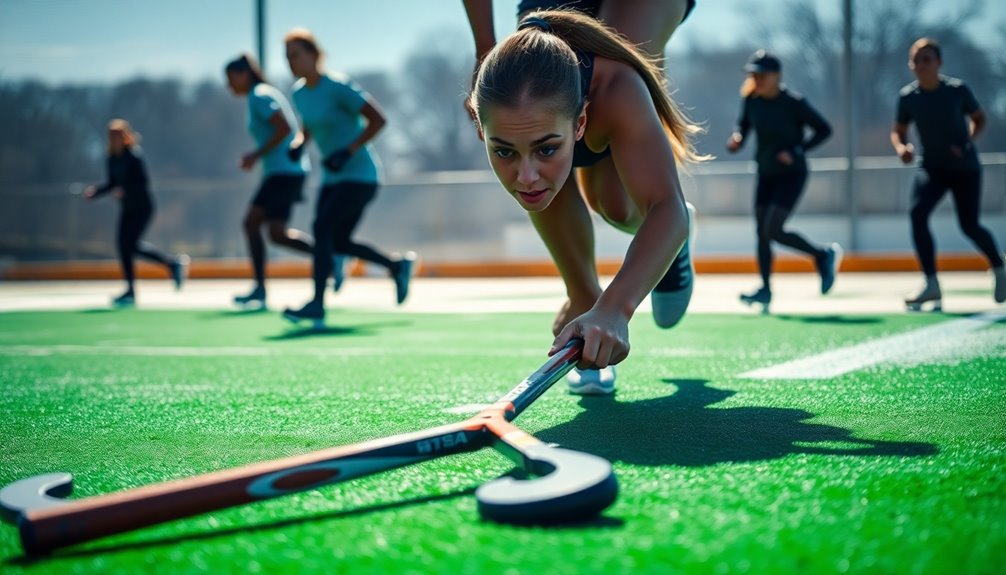
Crossovers are fundamental for every hockey player looking to enhance their game. Mastering crossovers greatly boosts your agility, allowing you to execute quick directional changes and weave through defenders with ease. When you perfect this skill, you become more elusive, making it harder for opponents to anticipate your moves.
Using both the outside and inside edges of your skates is essential for effective crossovers. This technique requires strength and proper body positioning, so focus on maintaining a bent knee posture. Keeping your knees bent not only increases your power and distance but also helps you maintain a consistent rhythm. Incorporating core strength exercises into your training can further support your balance and stability during crossovers. Additionally, developing explosive power is crucial for enhancing your ability to push off quickly during these movements.
Straightening your knees can lead to short, ineffective movements that compromise your speed on the ice or field.
Incorporating crossovers into your training tools is critical for improving your overall performance. Regular practice guarantees that you execute these movements fluidly, which enhances your momentum and efficiency during gameplay. Additionally, endurance building workouts are essential for maintaining high-intensity performance, especially during critical game moments.
Evolution of Crossover Techniques
Over the years, crossover techniques in hockey have transformed from basic methods to more advanced linear approaches. You'll notice how modern innovations enhance not just turning but also acceleration and agility on the ice. This evolution mirrors the way defensive strategies in basketball have shifted to adapt to new gameplay demands. Understanding these fundamental principles of defense can further elevate a player's overall performance on the ice. Effective communication and coordination among teammates can significantly improve a team's defensive resilience during gameplay.
Historical Technique Comparison
Evolving techniques in hockey have reshaped how players approach crossovers on the ice. Over the past two decades, traditional crossover techniques have shifted to linear crossovers, which have dramatically enhanced skating efficiency for hockey players. This change not only improves speed but also boosts puck control, enabling players to perform at higher levels.
Consider these key advancements:
- Increased acceleration during gameplay
- Enhanced agility for quick maneuvers
- Improved overall game performance in a short time
- Direct correlation between training and on-ice success
Today's game footage starkly contrasts with the past, showcasing the evolution of crossover execution and speed. Modern players adopt linear crossovers not just for turning but also for forward propulsion, making them indispensable in today's fast-paced game.
The structured training regimens focusing on these techniques lead to noticeable improvements, allowing you to elevate your performance rapidly. If you want to keep up with the game's demands, mastering these modern crossover techniques is essential for maximizing your skating efficiency and overall impact on the ice.
Embrace these changes, and you'll see the difference in your game.
Modern Skating Innovations
Recent advancements in skating techniques have revolutionized the way players utilize crossovers on the ice. You'll notice that the evolution from traditional methods to modern linear crossovers has greatly enhanced both your speed and agility.
Linear crossovers enable you to achieve better turning and forward propulsion, allowing for a more efficient skating style. This leads to improved performance on the ice compared to outdated techniques.
Today's players are capitalizing on these modern skating innovations to maintain momentum and enhance puck control, which is vital in competitive settings. As you train, consider how speed sets the top competitors apart from the rest.
Game footage from recent seasons starkly contrasts the skating efficiency of modern players with those from 15-20 years ago, underscoring the advantages of these advanced techniques.
To fully benefit from modern crossover techniques, it's important to engage in structured, hockey-specific training regimens. Focus on drills that enhance your speed and agility, ensuring you can execute these techniques effectively during gameplay.
Benefits of Crossovers for Speed
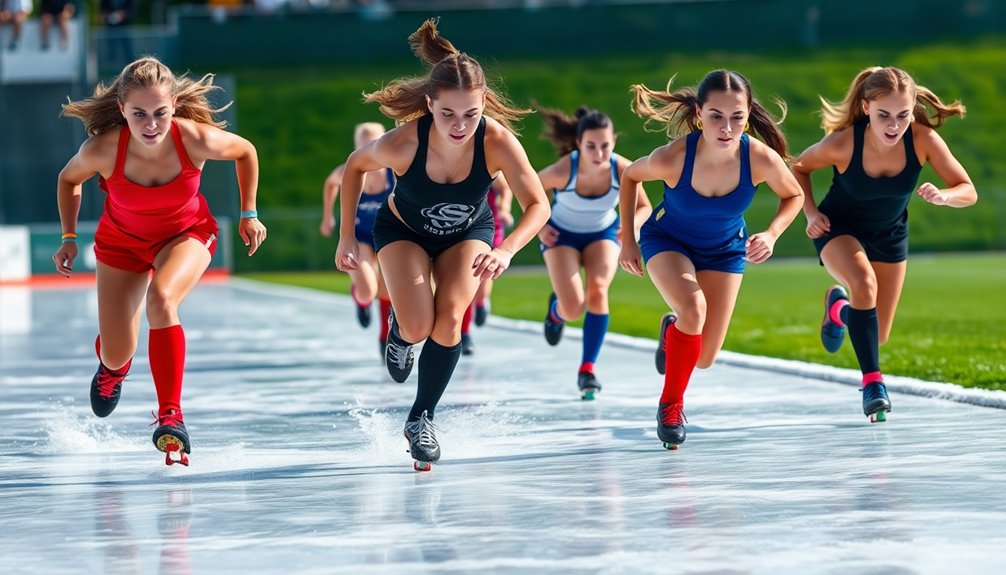
When you incorporate crossovers into your training routine, you'll quickly notice their significant impact on your skating speed. This isn't just about looking good on the ice; it's about enhancing your performance. The crossover technique allows you to maintain momentum while changing direction, vital for evading defenders and creating scoring opportunities.
You'll experience benefits like:
- Improved acceleration and agility, leading to faster on-ice performance.
- Strengthened hip adductors, essential for reaching higher skating velocities.
- Enhanced rhythm and efficiency, maximizing your power output during games. Additionally, incorporating power superset exercises can help improve your explosive strength and athletic performance, which is essential in hockey.
- Noticeable speed improvements within a month, impressing coaches and scouts. Additionally, consistent practice of agility training is crucial for refining your footwork and improving overall performance.
Players must regularly practice crossovers to reap these rewards. The linear crossover technique, in particular, stands out for its effectiveness compared to traditional methods. It contributes to a player's overall performance by allowing for smoother shifts and quicker responses. Consistent execution of crossovers not only elevates your skating speed but also builds confidence in your abilities. Additionally, incorporating cardio training can further enhance your stamina and speed on the ice, crucial for maintaining performance throughout the game.
Key Components of Effective Crossovers
To execute effective crossovers, you need to focus on several key components that will enhance your skating performance. First, maintain a strong knee bend. This position increases your power and distance; straightening your posture will only shorten your movements.
Next, utilize both the outside and inside edges of your blades during crossovers. Avoid the flat part of the blade to achieve ideal crossover performance, ensuring your glide and push-off are as efficient as possible.
Rhythm and foot movement are also essential. Consistent, fluid motions maximize your power and speed, allowing you to maintain momentum whether you're skating forward or backward. Incorporating interval training into your regimen can significantly improve your reaction time and endurance, which are crucial for executing effective crossovers. Engaging in cardio training not only boosts your stamina but also enhances your overall performance during high-intensity plays.
Additionally, proper upper body control is vital. Keep your chest and stick directed toward the curve, aligning your body movements with your intended direction. This will improve your overall balance and agility.
Lastly, work on specific drills to strengthen your edges. This practice will enhance your crossover performance and make you more elusive on the ice or field, making it harder for defenders to keep up. Incorporating pain shuttles drill into your training can significantly boost your endurance and agility, essential for making sharp crossovers in competitive scenarios.
Essential Ankle Mobility Exercises
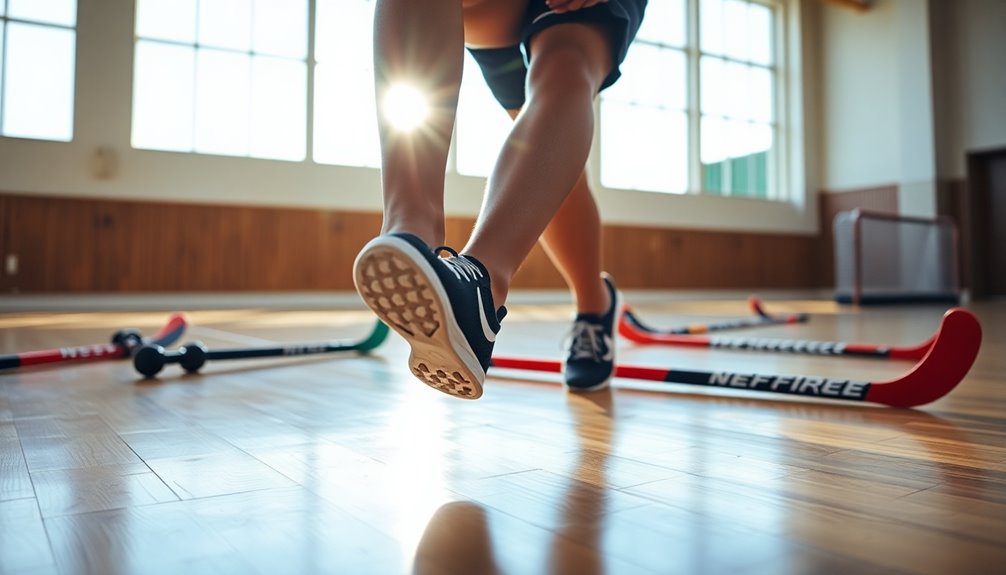
Your ankles play an essential role in achieving ideal skating performance, as their mobility directly influences your ability to maintain low positions and generate force efficiently. Incorporating effective defensive stance techniques can also enhance your stability during rapid movements. Moreover, a strong aerobic base is crucial for sustaining energy levels during intense skating sessions.
Improved ankle mobility enhances your skating mechanics, leading to better stride power and overall performance in hockey. Incorporating targeted exercises into your training can make a significant difference.
Here are four vital ankle mobility exercises you should include:
- Slider Dorsiflexion Glide: This movement helps increase dorsiflexion, critical for maintaining that low skating position.
- Single Leg Downward Dog Banded Ankle Stretch: This stretch enhances flexibility and stability, allowing for smoother changes and sharper turns.
- Calf Raises: Strengthening your calves improves both mobility and stability, supporting your agility on the ice or field.
- Heel-to-Toe Rocks: This simple exercise promotes proper range of motion and helps prevent compensations in your kinetic chain.
Commit to these ankle mobility drills, and you'll notice improvements in your agility and speed. Additionally, developing technical abilities through consistent practice is essential for maximizing your performance in sports like hockey.
Strengthening the Adductors
Strong hip adductors are essential for any hockey player looking to maximize their skating performance. Well-developed adductors peak in activation at higher skating velocities, which means they play a vital role in helping you achieve greater speed on the ice.
If you neglect adductor strength training, you risk predictable injuries, especially groin injuries that are common due to the demands of the sport.
To strengthen your adductors, incorporate specific exercises into your regimen. Effective options include the Copenhagen Plank, Puck Between the Knees Hip Thrust, and Lateral Slider Lunge. These exercises directly target your adductors, enhancing their strength and endurance.
Additionally, high-velocity linear crossover drills, like the McDavid Linear Crossover, can further activate these muscles during skating maneuvers, providing specific performance gains.
Proper Knee Bend Techniques
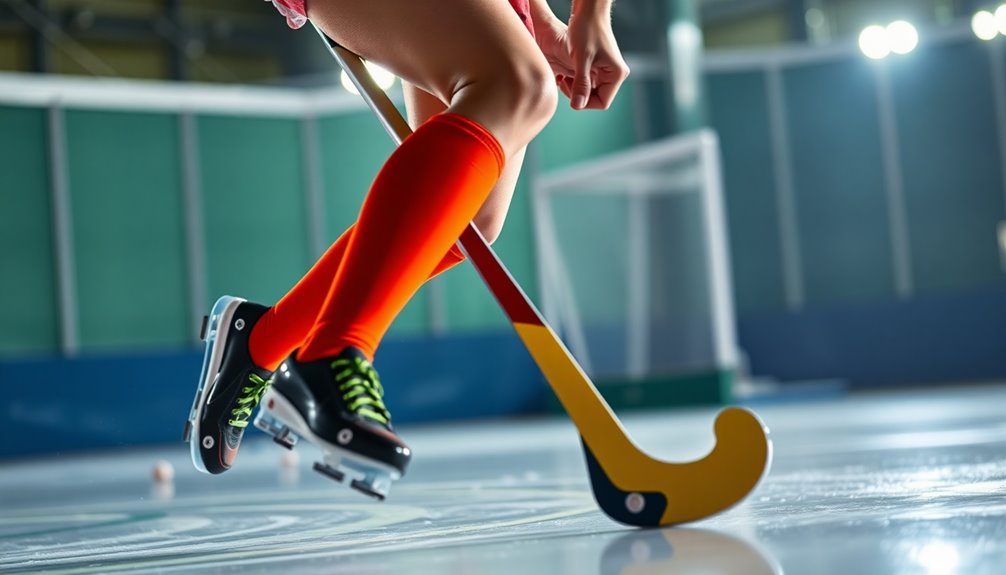
Building on the importance of adductor strength, mastering proper knee bend techniques can greatly enhance your crossover power in hockey.
When you bend your knees correctly, you'll notice longer strides and increased distance during each crossover. It's essential to maintain a deep knee bend; a straight posture leads to shorter, less effective movements.
Focus on these key aspects for effective knee bend:
- A bent knee on your lifted leg boosts your push-off power.
- Extend your outside foot to optimize leverage and balance.
- Keep a consistent knee bend to improve overall balance and control.
- Embrace the fluidity of motion, allowing smoother shifts between edges.
Mastering Edge Control
Mastering edge control is essential for enhancing your performance on the ice.
By strengthening your edges and practicing specific techniques, you'll improve your ability to maneuver during crossovers.
Let's explore how these skills can boost your agility and speed.
Importance of Edge Strength
Edge strength is essential for hockey players looking to enhance their performance on the ice.
When you master edge control, you reveal a level of agility that sets you apart on the rink. Strong edges allow you to make quick directional changes and maintain speed, making it harder for defenders to predict your next move.
Here's why focusing on edge strength is crucial:
- It boosts your skating efficiency, letting you glide with less effort.
- You'll execute crossovers with more power, enhancing your push-off technique.
- Improved balance and control lead to increased speed during crossovers.
- Targeted drills prevent injuries that often arise from weak edges.
Techniques for Edge Mastery
To truly excel on the ice, you need to focus on techniques that enhance your control over both the inside and outside edges of your skates. Mastering edge control is crucial, especially during crossovers, where one skate operates on the outside edge while the other glides on the inside edge.
To optimize your performance, bend your knees properly; straight posture leads to shorter, less effective movements.
Your push-off technique is essential. Maintain a consistent push-off that engages both edges, contributing to your acceleration and agility. Additionally, guarantee proper upper body alignment—keep your chest, eyes, and stick directed toward the center of the curve. This alignment helps your body movements correspond with your intended direction, enhancing balance and control.
Practice rhythm-based crossover drills regularly; they'll notably improve your edge mastery. A consistent rhythm maximizes foot movement efficiency and power, allowing you to react swiftly during a game.
As you refine these techniques, you'll notice how well your skates work together, making your Hockey Reaction faster and more effective on the ice. Embrace these practices, and you'll elevate your game notably!
Upper Body Positioning Tips
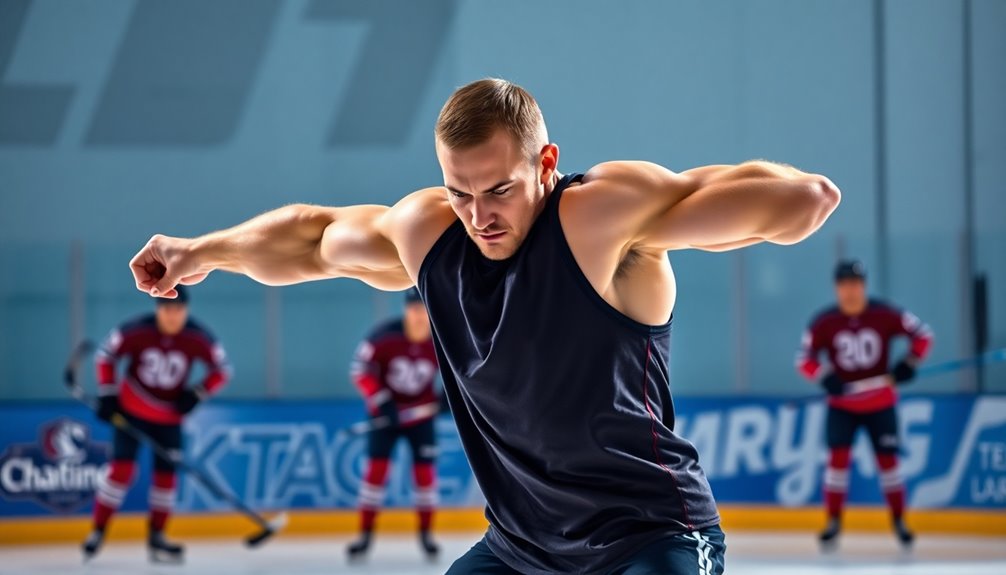
When executing crossovers in hockey, proper upper body positioning is essential for maintaining balance and control. Your upper body plays a vital role in allowing players to react quickly and efficiently during maneuvers. Keep your chest, eyes, and stick directed towards the center of the curve to enhance your stability.
Here are key tips for effective upper body positioning:
- Align your upper body movements with your stick direction to promote efficiency.
- Maintain level shoulders; slight dips in the inside shoulder are okay, but avoid extreme leans.
- Bend your knees instead of keeping a straight posture to increase power and distance during crossovers.
- Consistently practice your positioning to build muscle memory and improve your overall crossover execution.
Developing Rhythm in Crossovers
Developing a consistent rhythm in your crossovers can transform your performance on the ice. This rhythm is vital for maximizing your power and speed, allowing for continuous foot movement without interruption. To enhance your rhythm, incorporate regular crossover drills into your practice. These drills not only improve your technique but also help you develop that all-important flow during gameplay.
As you practice, remember that pushing through discomfort is essential. Embracing the challenge helps cultivate a natural rhythm, which is key for maintaining momentum while you navigate the rink or field. Pay attention to your knee bend and foot positioning, as these elements greatly influence the effectiveness and distance of each crossover.
Don't forget about your upper body! Keeping your chest and stick aligned with your direction of movement supports a smooth execution of crossovers. This alignment enhances your overall rhythm, making your movements more fluid and effective.
Common Crossover Mistakes to Avoid
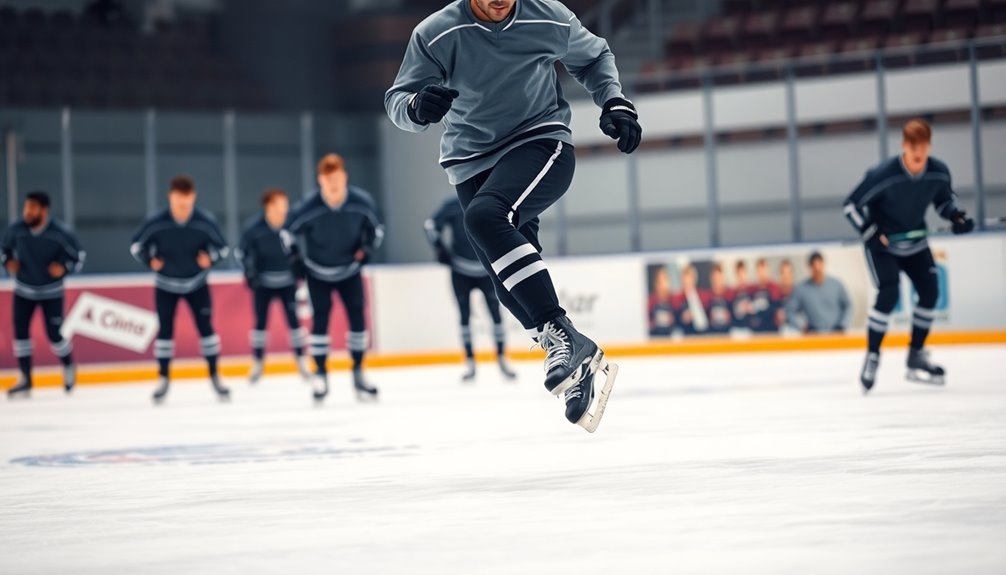
A smooth rhythm can only take you so far if you're making common mistakes during crossovers. To truly excel, you need to focus on proper technique and avoid these pitfalls:
- Neglecting knee bend: Not bending your knees can lead to shorter, less powerful crossovers.
- Improper edge position: Failing to keep one skate on the outside edge and the other on the inside edge reduces your power and efficiency.
- Misaligned upper body: If your chest, eyes, and stick aren't aligned with the direction of the crossover, it disrupts your balance and control, making it harder to execute effectively.
- Inconsistent rhythm: A lack of steady tempo can hinder your speed and power, making each crossover less effective.
These mistakes can sabotage your progress, so it's essential to identify and correct them.
Consistent practice of drills that reinforce proper technique will help you avoid these errors.
Integrating Crossovers Into Training
Integrating crossovers into your training regimen can remarkably elevate your performance on the ice or field. By incorporating forward crossovers into your sessions, you'll enhance your agility and speed, both of which are essential for success in ice and field hockey.
Practicing crossovers on both inside and outside edges not only develops strength but also builds stability, enabling you to execute sharp turns and directional changes with ease.
Implementing regular crossover drills, like the McDavid Linear Crossover, can greatly improve your knee bend and foot positioning. This leads to longer and more powerful strides, vital for maintaining momentum during games.
Don't underestimate the importance of rhythm; maintaining a consistent pace during crossover workouts promotes efficiency, helping you sustain high-speed movements without exhausting your energy reserves.
Additionally, integrating ankle mobility and stability drills into your crossover training can further enhance your ability to maintain low skating positions.
This combination allows you to generate force effectively, making you a more formidable player on the ice or field. Embrace these strategies, and watch your performance soar.
Creating a Crossover Workout Plan
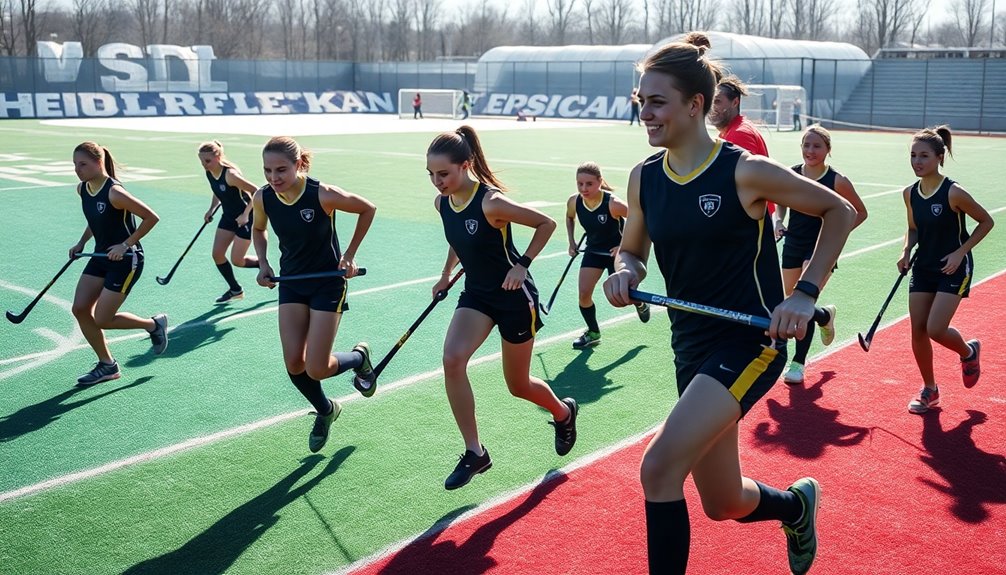
Creating a focused crossover workout plan can greatly enhance your skating performance by targeting crucial skills. To get the most out of your training, you need to be able to incorporate both linear and traditional crossover drills. This will help with forward propulsion and agility, essential for the sport of hockey.
Here are some key elements to include in your plan:
- Ankle mobility and stability exercises to improve force production.
- Adductor strength workouts like the Copenhagen Plank for stronger crossovers.
- Drills for continuous foot movement to establish rhythm and consistency.
- Proper knee bend and upper body alignment to maintain technique.
You should know exactly what drills to incorporate to suit your skill level. Regularly scheduled workouts, tailored to your needs, can yield noticeable improvements in performance within a month.
Measuring Progress in Crossover Skills
To effectively measure your progress in crossover skills, it's crucial to identify key performance indicators that track your speed and technique.
Regularly using video analysis techniques can give you valuable insights into your form, while consistently tracking your drill performance helps you see improvements over time.
Key Performance Indicators
Measuring progress in crossover skills is vital for any hockey player looking to enhance their performance on the ice. To effectively track your development, focus on key performance indicators (KPIs) that reflect your growth.
Here are some significant KPIs to take into account:
- The number of successful crossovers executed in a set time frame, showcasing speed and efficiency.
- Average distance covered per crossover, providing insights into your power and technique.
- Time taken to complete a defined course using crossovers, quantifying agility and quickness during gameplay.
- Ability to maintain proper edge control, indicating your strength and stability in the kinetic chain.
Additionally, incorporating tools like the Reaction Ball can help you further refine your crossover skills. By practicing drills that challenge your reaction times and coordination, you'll see improvements in crossover speed, especially in high-velocity situations like the McDavid Linear Crossover.
Monitoring these KPIs won't only keep you motivated but also guarantee you're on the right track to becoming a more skilled and efficient player on the ice. Embrace this journey and enjoy the progress you'll make!
Video Analysis Techniques
How can video analysis transform your approach to improving crossover skills? By incorporating video feedback strategies into your training, you can visually track and evaluate your crossover technique in real-time. This powerful tool allows you to identify areas for improvement, helping you refine your skills effectively.
Using slow-motion playback, you can catch subtle mistakes, such as knee bend, foot positioning, and upper body control during crossovers. This detailed examination is essential for making necessary adjustments.
Additionally, employing angle evaluation techniques lets you analyze footage from various perspectives, offering a thorough view of your edge usage and rhythm consistency—both critical for effective crossovers.
You can also implement performance comparison methods by recording your crossover drills and measuring them against ideal performance models. This quantitative approach enables you to see your progress clearly and identify specific aspects to work on.
Regularly reviewing your footage not only highlights improvements over time but also motivates you to maintain a structured training regimen focused on enhancing your crossover skills.
Embrace video analysis, and watch your performance soar!
Drill Consistency Tracking
Tracking drill consistency is vital for gauging your progress in crossover skills. To effectively measure your improvement, start by establishing a baseline. Time yourself and count the successful crossovers performed within a set duration. This will help you understand your initial skill level.
Incorporate a few key strategies to enhance your training:
- Maintain a training log to record daily crossover drills, noting challenges and improvements.
- Utilize drill performance analysis to pinpoint areas for technique adjustment feedback.
- Implement a scoring system that combines speed, accuracy, and technique to quantify your progress.
- Track incremental improvements in speed and fluidity, aiming for noticeable enhancements within a month.
Regular practice session consistency is essential for your development.
With video analysis, you can review your technique and guarantee you're on the right track. This targeted feedback allows you to make necessary adjustments, ultimately enhancing your performance.
By actively monitoring your progress, accountability increases, fueling your motivation to push further.
Conclusion
So, you thought crossovers were just for figure skaters? Think again! Mastering this essential technique can elevate your ice and field hockey game to new heights. By focusing on speed, agility, and proper form, you'll not only outmaneuver your opponents but also impress them with your newfound skills. Remember, it's not just about looking good on the ice or field; it's about making those crossovers work for you. Now, go show the world what you've got!

